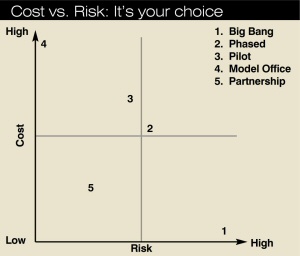PUBLIC
SECTOR
Tick the boxes and ask the people
Our Deputy PM wants local councils to make contact easier for council tax payers.
Paul Hartland and Colin Stebbing, of SITEL Consulting, have some advice
Question: When is a call centre not a call centre?
Answer: When it's a switchboard. Boom, boom!
A NUMBER of large central government departments have enthusiastically, if not
always entirely successfully, embraced call centres as their primary method
of communicating with customers.
And most local councils also support the idea of carrying out business by phone.
However, many still do so through their switchboards and within compartmentalised
processes.
Each year, local authorities report on their e-government activity to the Deputy
Prime Minister. The 2003 returns suggest that most are either considering setting
up a call centre or are in the implementation phase.
Even those who say they are in this phase, a significant proportion of the questions
at our conferences comprise:
"How many people do we need?"
"What comes first -- technology or people?"
"What approach should I use for implementation -- big bang or phased?"
"Do we need CRM?"
"How can we convince the remainder of the organisation that we can efficiently
deliver services for which they are currently responsible?”
The answers? It's all in the planning and execution. When looking to open a
call centre, the first question to ask yourself is: "Why are we doing this?”

"Numbers...numbers" |
The
returns to the Deputy PM partially answers the question: because the Government
has set e-business targets for the public sector. Is this a good enough
reason? Possibly.
However, there are other equally if not more compelling reasons. If we start
from the premise that the main reason for having a call centre is to achieve
the Government target, we potentially miss an opportunity to focus on some
of the other benefits a call centre will bring.
Consolidation brings opportunities to gain efficiency and reduce cost; opportunities
also exist to improve the customer experience through greater consistency,
improved accessibility and better transaction handling quality -- in terms
of speed of response, accuracy of information and quality of call handling. |
Perhaps the biggest
potential benefit of all, though, is the availability of a single number for
a customer to call, and the confidence that the first person the customer speaks
to will have access to the information they need to be able to answer the question.
If we haven't already asked our customers how they feel about our services,
now is perhaps a good time to do so, since this will then give us a benchmark
against which to measure our call centre operation.
In order to achieve all of the potential benefits, we need firstly to understand
the current workload, and factor in any known changes. Ask:
· What work do we actually carry out?
· What are the associated back office functions?
· Is there any fulfilment requirement?
· What are the possible outputs from each transaction?
· What is the impact on other departments?
· What are the interfaces with other departments, and what service level
agreements do we have/need to have?
· What delivery channels do we want to support?
Most importantly, how do all of the above impact on the customer? Having defined
what types of work we intend to undertake in our call centre, we need to have
robust end-to-end processes in place to carry them out. Questions we need to
ask at this point include:
· How do we do it now?
Is it efficient?
· How can we measure whether people are following the defined processes?

"An
average of 31 per cent of all
calls were identified as 'waste calls'" |
In
a recent survey, an average of 31 per cent of all calls were identified
as "waste calls", that is calls generated by inefficient processes
within other areas of the business. Examples are chase calls caused by a
failure to meet commitments made to customers or enquiries generated by
a confusing letter.
Having defined what we do and how we are going to do it, the next question
is size. Size matters, despite what people say!
· How many transactions are we expecting?
· When are we expecting them to arrive? (What month, day, hour, or
even 15-minute time slot?)
· How quickly are we going to respond? (service levels)
Often overlooked is the fact that much of the demand is generated by our
own actions -- or, in some cases, inactions. It is worth considering how
we can proactively manage our activities to reduce peaks in demand, since
this will make it a great deal easier to efficiently resource to meet demand. |
Most call centre
managers understand the need to forecast call demand and plan to meet it; often
overlooked is the forecasting and resourcing of non-telephone related activity.
Location for most local authorities is likely to be driven by current location
and availability of space in current facilities, however suitability in terms
of internal environment and external infrastructure (transport, parking) should
be considered.
Having identified why, what, how many and when, we need to think about the technology
we need to support our vision - as opposed to making assumptions around what
we would normally expect to see in a call centre.
Where to start? Back to strategy. If strategic vision defines the direction
in which the business is heading, it must also define the technology required
to get there. So, our original premise - "To handle 90pc of contacts electronically
by 2006" -- defines our channel strategy, and tells us we need the technology
to handle e-mail and possibly web based transactions.
How do you currently manage your contacts? By reviewing what we have now, we
can identify the gaps against where we want to be. The current telephony and
data set up may just need some minor tweaks to allow it to perform some of today's
automated functions.
For
example, do we need CRM? If you are implementing CRM do you need a whole
new database or is it compatible with your legacy system? Or do we simply
need a database that everyone can access without the bells and whistles?
This is where you may need assistance from a technology consultant - the
problem with going to a salesperson is they will sell to you!
What technology do you need (as opposed to would like...) to deploy to achieve
your vision?
To achieve the stated targets deploying the right technology is essential
and this is identified through the due diligence process where contact types
can be categorised into Commodity, Complex, Comfort. |
|
The next step
is to allocate technologies to the respective types. For example, commodity
calls - such as checking council tax -- are easily handled by IVR.
The ultimate goal has to be to improve the customer experience whilst increasing
the efficiency of your business processes, and reducing the amount of manual
attention needed to complete a customer transaction.
For example, if a caller needs to know the status of a planning application,
they should obtain an instant response from the advisor who answers the telephone.
From the advisor's point of view they should be able to search the system by
typing in an appropriate personal identifier - such as the postcode -- and obtain
the information with the minimum of key strokes or mouse clicks.
This approach should enable you to stay focussed on the objectives of implementing
technology and not get drawn into the detailed debates about the functionality
of each piece of kit you require.
Having ticked all of the above boxes, the next big decision is, what implementation
approach to choose (see chart).
Big Bang is a great low cost option for a small and uncomplicated operation,
where there are fewer people to upset and there is less to go wrong.
A phased approach is a great way to reduce the risk if the operation is large
and uncomplicated.
If, however, as is often the case, we are working with a complex solution based
on a degree of assumption, particularly in a risk-averse culture, a pilot gives
us greater opportunity to identify and resolve issues with a relatively small
group of customers and staff. A model office reduces this risk even further
by completely removing live customers from the equation.
Partnership is an approach rather than a true methodology in its own right,
since the actual implementation options are the same regardless of whether one
or more organisations are involved.
However, almost every implementation involves partnership on some level, even
if this is limited to supplier relationships.
A true partnership approach with a supplier with specific call centre expertise
offers unique advantages, especially if call centres are a necessary communication
tool as opposed to a core part of your business.
Access to call centre expertise from the planning stage onward means that specialist
experience can be brought to bear which, providing advice is heeded, results
in fewer unpleasant surprises when it comes to implementation.
The final question is: "Were we successful?"
The answer will, of course, depend on how effective we were when we formulated
our strategy. If we identified critical success factors, and decided how we
were going to measure them, our post implementation review will rely on fact
rather than opinion.
The only thing that remains is to validate whether or not we had the positive
effect on our customers, our people and our cost that we planned to.
The cost comparison is a straightforward spend vs. budget calculation.
As to our customers and our people, why not ask them?!
Profiles Paul Hartland
and Colin Stebbing
SITEL Consulting is part of SITEL Corporation, whose call centres handle 2m-plus
customer contacts a day.

 |
Paul Hartland, senior consultant, held senior positions - including call
centre manager - with a utility company before joining SITEL in 1996.
Among his projects was to set up a 100-seat call centre.
He joined SITEL Consulting in September 2000. Part of his job is to project
manage for a major public sector body and he has also has been involved
in a number of local authority projects.
Colin Stebbing, consultant, joined SITEL Consulting in 2001. He was previously
with two big field service where he managed new technology projects, business
process improvement and call centre relocations. He has wide call centre
experience in the public sector.
|
Mr Stebbing is
also course director for the Certificate in Call Centre Management, validated
by the Open University Validation Service.
Fast facts: Readers who use our enquiry service will receive
details about the services offered by SITEL Consulting. From the home page,
please click on Reader Enquiry and enter number 58/70




